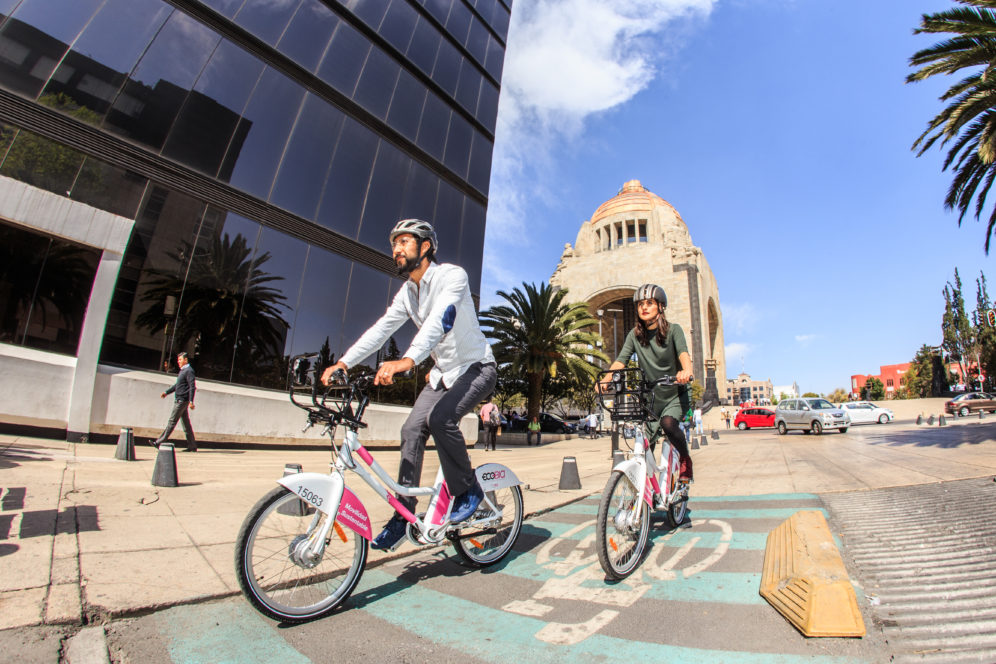
December 06, 2019
New ITDP Report Helps Cities “Plug” E-bikes and E-scooters into their Transport Networks
The report encourages cities to take an active role in managing the use of e-bikes, e-scooters, and other electric micromobility modes, to maximize benefits and minimize negative impacts.
Within the past couple of years, cities have witnessed a proliferation of personal mobility devices: electric scooters and electric bicycles—many of which are dockless and shared—have become commonplace along downtown thoroughfares and enthusiastically adopted by people across the globe. While cities stand to benefit from these devices, technology companies have, for the most part, taken the lead on development and adoption. Every week there appears to be a new technology or mobility company moving into the micromobility market, which continues to grow as people realize the opportunities these devices can offer – convenient access to transit, shorter commutes, and more pleasant trips.
Recognizing the uncertainty many cities face in managing the rapid growth of electric bicycle and scooter use, a new report published by the Institute for Transportation and Development Policy (ITDP) offers analysis and recommendations for cities to link e-bikes and e-scooters to sustainable transport goals and expand the benefits of these low-carbon modes. The Electric Assist: Leveraging E-bikes and E-scooters for More Livable Cities provides practitioners and decision makers with a comprehensive understanding of the potential opportunities and risks posed by e-bikes and e-scooters, as well as recommendations for cultivating safe, equitable use of these modes.
What is electric micromobility? The term, which is evolving along with technology, is used in this report to refer to electric-powered modes of transport that are low-speed (comparable to a bicycle), small, lightweight, and typically used for trips up to 10 km. This primarily includes electric bicycles and standing e-scooters, but also other small electric devices, either shared or personally owned.
“There are only a few cities out there thinking about e-bikes and e-scooters as a real piece of the solution to reducing car dependence and shifting city residents to reliable, low-carbon alternatives,” said Dana Yanocha, principal author of the report. “Safety and affordability are primary concerns for cities when it comes to electric micromobility, and the popularity of these modes—both for cyclists and for those who would never consider riding a pedal bicycle—underscores the need for more thoughtfully-designed protected infrastructure. We hope that The Electric Assist will help cities understand the role electric micromobillity can play in moving toward a transportation system that’s not dominated by single occupancy vehicle trips.”


E-bikes and e-scooters have reduced users’ car trips in cities from Santa Monica to Santiago. The role of e-bikes and e-scooters in reducing harm to the environment—one of the six sustainable transport goals evaluated in the report— was discussed by ITDP, NGO partners, and cities at a Climate Week event earlier this year. At that event, Harriet Tregoning, Director of the New Urban Mobility alliance (NUMO), underscored that micromobility could replace cars as the new “vision” for personal mobility, particularly in places where land uses facilitate short trips. Seattle DOT’s then Chief of Strategy and Innovation, Benjamin de la Peña, shared Seattle’s vision for shared e-micromobility to act as a lever to decarbonize cities and accelerate implementation of safe infrastructure for non-car users. Toward this goal, Seattle is actively building infrastructure to support all micromobility modes. “We don’t know what technology is coming,” de la Peña said, “But we know the kind of city we want.” Karina Ricks, Director of Mobility and Infrastructure for the City of Pittsburgh echoed this point of view, and recommended cities work closely with shared micromobility operators to make sure their services align with city goals for equity, safety, and reducing environmental harm. Ricks also recognized that cities might get things wrong the first time. “If you fail, fail fast,” she encouraged, urging cities to regroup and try again. The overwhelming opinion that emerged at the event was that e-micromobility presents a tremendous opportunity to cut emissions and get people out of cars, but cities have to be proactive and creative to unleash that potential.


The new ITDP report gives cities the tools to get things right—ensuring that access to shared services is equitable and affordable, and that shared and personal e-bike and e-scooter users have safe, accessible spaces to ride and park. To expand access to and oversight of electric micromobility in the near term, ITDP recommends that cities:
- Legalize use of e-bikes and e-scooters, and classify them as non-motor vehicles
- Standardize speed maximums for electric modes when using cycling infrastructure
- Design safe cycling and parking infrastructure that accommodates both electric and non-electric devices
- Manage and regulate shared electric micromobility systems
- Monitor use and ridership trends using surveys and shared operator data.
The release of The Electric Assist also included a webinar, which reviewed the report’s key takeaways and featured a brief overview of ITDP’s Climate Week event as well as a case study of e-bike and e-scooter use in Mexico City. A recording and presentation slides from the webinar are available here.

